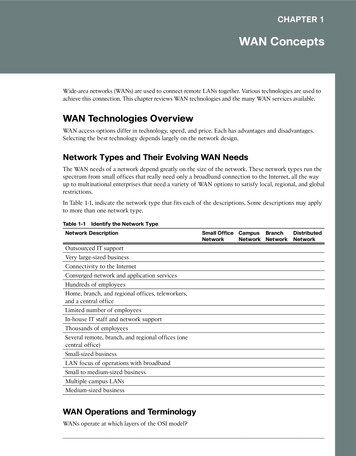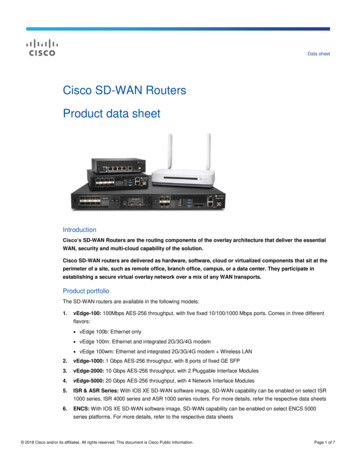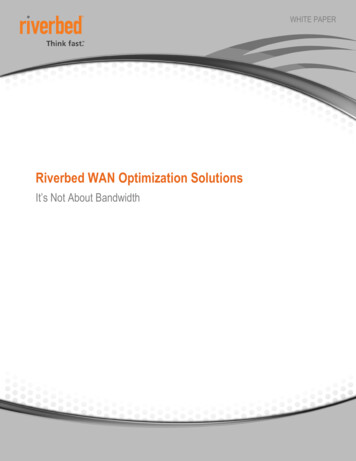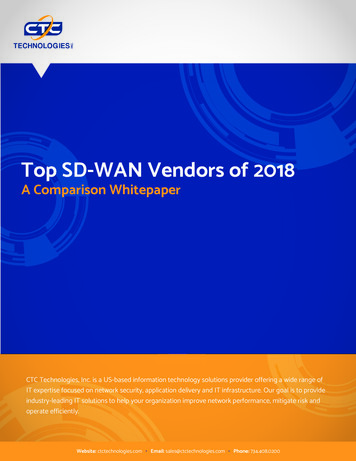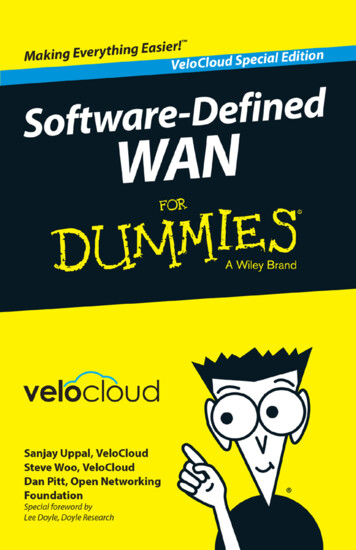
Transcription
Software‐DefinedWANBy Sanjay Uppal, Steve Wooand Dan PittSpecial Foreword by Lee DoyleThese materials are 2015 John Wiley & Sons, Ltd. Any dissemination, distribution, or unauthorized use is strictly prohibited.
Software‐Defined WAN For Dummies Published byJohn Wiley & Sons, LtdThe AtriumSouthern GateChichesterWest SussexPO19 8SQEnglandFor details on how to create a custom For Dummies book for your business or organisation, contactCorporateDevelopment@wiley.com. For information about licensing the For Dummies brand forproducts or services, contact BrandedRights&Licenses@Wiley.com.Visit our Home Page on www.customdummies.comCopyright 2015 by John Wiley & Sons Ltd, Chichester, West Sussex, EnglandAll Rights Reserved. No part of this publication may be reproduced, stored in a retrieval system ortransmitted in any form or by any means, electronic, mechanical, photocopying, recording, scanningor otherwise, except under the terms of the Copyright, Designs and Patents Act 1988 or under theterms of a licence issued by the Copyright Licensing Agency Ltd, 90 Tottenham Court Road, London,W1T 4LP, UK, without the permission in writing of the Publisher. Requests to the Publisher for permission should be addressed to the Permissions Department, John Wiley & Sons, Ltd, The Atrium,Southern Gate, Chichester, West Sussex, PO19 8SQ, England, or emailed to permreq@wiley.com,or faxed to (44) 1243 770620.Trademarks: Wiley, the Wiley Publishing logo, For Dummies, the Dummies Man logo, A Referencefor the Rest of Us!, The Dummies Way, Dummies Daily, The Fun and Easy Way, Dummies.com andrelated trade dress are trademarks or registered trademarks of John Wiley & Sons, Inc. and/or itsaffiliates in the United States and other countries, and may not be used without written permission.All other trademarks are the property of their respective owners. Wiley Publishing, Inc., is not associated with any product or vendor mentioned in this book.LIMIT OF LIABILITY/DISCLAIMER OF WARRANTY: THE PUBLISHER, THE AUTHOR, ANDANYONE ELSE INVOLVED IN PREPARING THIS WORK MAKE NO REPRESENTATIONS ORWARRANTIES WITH RESPECT TO THE ACCURACY OR COMPLETENESS OF THE CONTENTS OFTHIS WORK AND SPECIFICALLY DISCLAIM ALL WARRANTIES, INCLUDING WITHOUTLIMITATION WARRANTIES OF FITNESS FOR A PARTICULAR PURPOSE. NO WARRANTY MAYBE CREATED OR EXTENDED BY SALES OR PROMOTIONAL MATERIALS. THE ADVICE ANDSTRATEGIES CONTAINED HEREIN MAY NOT BE SUITABLE FOR EVERY SITUATION. THIS WORKIS SOLD WITH THE UNDERSTANDING THAT THE PUBLISHER IS NOT ENGAGED IN RENDERINGLEGAL, ACCOUNTING, OR OTHER PROFESSIONAL SERVICES. IF PROFESSIONAL ASSISTANCEIS REQUIRED, THE SERVICES OF A COMPETENT PROFESSIONAL PERSON SHOULD BE SOUGHT.NEITHER THE PUBLISHER NOR THE AUTHOR SHALL BE LIABLE FOR DAMAGES ARISINGHEREFROM. THE FACT THAT AN ORGANIZATION OR WEBSITE IS REFERRED TO IN THIS WORKAS A CITATION AND/OR A POTENTIAL SOURCE OF FURTHER INFORMATION DOES NOT MEANTHAT THE AUTHOR OR THE PUBLISHER ENDORSES THE INFORMATION THE ORGANIZATIONOR WEBSITE MAY PROVIDE OR RECOMMENDATIONS IT MAY MAKE. FURTHER, READERSSHOULD BE AWARE THAT INTERNET WEBSITES LISTED IN THIS WORK MAY HAVE CHANGEDOR DISAPPEARED BETWEEN WHEN THIS WORK WAS WRITTEN AND WHEN IT IS READ.Wiley also publishes its books in a variety of electronic formats. Some content that appears in printmay not be available in electronic books.ISBN: 978‐1‐119‐10148‐2 (pbk); 978‐1‐119‐10147‐5 (ebk)Printed and bound in Great Britain by Page Bros, Norwich10 9 8 7 6 5 4 3 2 1These materials are 2015 John Wiley & Sons, Ltd. Any dissemination, distribution, or unauthorized use is strictly prohibited.
Table of ContentsForeword.viiDefining SD‐WAN and Understanding its Importance. viiChanging traffic patterns: SaaS, cloud,mobile, video. viiSD‐WAN Benefits. viiiHighlighting SD‐WAN Buying Considerations. viiiReaching Conclusions and Making Recommendations. ixIntroduction. 1About This Book. 2Foolish Assumptions. 2How This Book Is Organized. 2Icons Used in This Book. 3Where to Go from Here. 3Chapter 1: Taking an Overview ofSoftware‐Defined WAN. . . . . . . . . . . . . . . . . . . . . . . . . . 5Defining Software‐Defined WAN. 5Meeting the SDN principle of network abstraction. 6Separating functionality into controland data planes. 6Understanding the Need for SD‐WAN. 7Dealing with applications hindered by expensivebandwidth. 7Tackling branch deployments delayedby IT complexity. 8Considering cloud migration not supported bystatic architectures. 9Figuring Out What SD‐WAN Is Not. 10Discovering the Features of SD‐WAN. 10Virtualizing the network. 11Enabling a secure overlay. 11Simplifying services delivery. 11Providing interoperability. 12Leveraging cost‐effective hardware. 12These materials are 2015 John Wiley & Sons, Ltd. Any dissemination, distribution, or unauthorized use is strictly prohibited.
ivSoftware-Defined WAN For DummiesSupporting automation with businesspolicy framework. 13Monitoring usage and performance. 13Supporting interoperable and open networking. 13Enabling managed services. 14Chapter 2: Surveying SD‐WAN Architecture. . . . . . . . . 15Identifying the Challenges that Face a Traditional WAN. 15Need to simplify WAN for enterprise branchoffices. 16Inefficient WAN utilization. 16Secure communications. 16Rigid WAN circuit requirements. 17Complex service delivery. 17Cloud migration. 17Managed Service Provider ready. 18Analyzing SD‐WAN Architecture. 18Secure cloud network. 18Virtual service delivery. 20Orchestration and analytics. 22Appreciating the Advantages of SD‐WANover Traditional WAN. 23Chapter 3: Deploying SD‐WAN. . . . . . . . . . . . . . . . . . . . . 25Connecting Enterprise to Cloud Services with SD‐WAN. 25Looking at Deployment Options. 27Internet WAN branch using SD‐WAN. 29Hybrid WAN branch using SD‐WAN. 29Maximizing the Performance Benefits of UsingHeterogeneous Networks. 30Migrating to SD‐WAN. 31Chapter 4: Counting the Benefits of SD‐WANfor Enterprises. . . . . . . . . . . . . . . . . . . . . . . . . . . . . . . . . 33Improving Business Agility with a Software‐DefinedSolution. 33Driving IT Efficiency with Automation and CloudManagement. 34Enabling the Migration to Cloud Services andApplications. 36Reducing Overall Costs and Helping ITBudget Management. 37These materials are 2015 John Wiley & Sons, Ltd. Any dissemination, distribution, or unauthorized use is strictly prohibited.
Table of ContentsvChapter 5: Looking to the SD‐WAN Future. . . . . . . . . . . 39Surveying the Current Scope of SD‐WAN. 39Extending SD‐WAN for Mobility. 40Pairing SD‐WAN and the Internet of Things. 41Comparing SD‐WAN and NFV. 42Chapter 6: Top Ten Considerations forEnterprise Adoption of SD‐WAN . . . . . . . . . . . . . . . . . 43SD‐WAN Considerations. 44Flexible Deployment Options. 44Transport‐Independent Design. 44Network Service Insertion. 44Incremental Migration and Interoperability. 45Optimized and Secure Access to SaaS and EnterpriseApplications. 45Scalable, Redundant and Resilient Controland Data Plane. 45Ease of ICOM (Installation, Configuration, Operationsand Management). 46Programmability. 46A Secure and Encrypted Overlay. 46Consider a Purpose‐Built SD‐WAN Solution. 46These materials are 2015 John Wiley & Sons, Ltd. Any dissemination, distribution, or unauthorized use is strictly prohibited.
viSoftware-Defined WAN For DummiesThese materials are 2015 John Wiley & Sons, Ltd. Any dissemination, distribution, or unauthorized use is strictly prohibited.
ForewordSoftware‐Defined WAN, or SD‐WAN for short, is at the leading edge of software‐based networking deployments.SD‐WAN offers significant business value for organizationswith distributed branches in terms of business agility and theability to leverage Internet bandwidth economics – put simply,cost savings.This Software‐Defined WAN For Dummies book explains theway for IT and business managers to migrate to a distributednetwork which is less complex, more flexible and easier tomanage. With this book, VeloCloud and Dan Pitt make animportant contribution to better understanding the future ofWAN implementations.Defining SD‐WAN andUnderstanding its ImportanceSD‐WAN uses software and cloud‐based technologies to simplify delivery of WAN services to branch offices. Software‐based virtualization enables network abstraction that resultsin simplification of network operations. SD‐WAN enables ITand business managers to deploy Internet‐based connectivity(with its benefits of ubiquity, high bandwidth and low cost)easily, quickly and with quality, reliability and security.Changing traffic patterns:SaaS, cloud, mobile, videoThe evolution of IT technologies has altered traffic flowswithin distributed organizations. Not only do remote usersrequire significantly more bandwidth (for example, whenusing video), but they also need to directly access SaaS/cloud‐based applications such as Saleforce, Office 365, Lync andoff‐premise storage (such as Dropbox, Evernote, and so on).These materials are 2015 John Wiley & Sons, Ltd. Any dissemination, distribution, or unauthorized use is strictly prohibited.
viiiSoftware-Defined WAN For Dummies Traditional MPLS networks which transmit all traffic from thebranch to a centralized data center can’t offer low latency/high performance access to cloud applications. In addition,the security and management requirements associated withdisparate traffic flows have added to the complexity of managing branch operations – thus increasing operational (staffing)costs for many IT organizations.SD‐WAN BenefitsIn contrast, SD‐WAN provides a wide range of benefits for distributed organizations, including: Business agility. Rapid deployment of WAN services(such as bandwidth and firewall) to distributed branchoperations without the need to send IT personnel on‐site.Bandwidth can be easily added (with additional circuits)or reduced as business requirements evolve. Internet economics. Internet connectivity (includingcable, DSL and ethernet) is widely available, quick todeploy and a fraction of the cost of equivalent MPLS circuits. SD‐WAN provides the benefits of reliable,secure WAN service at Internet price points. Optimized cloud architecture. SD‐WAN eliminatesthe backhaul penalties of traditional MPLS networksand l everages the Internet to provide secure, high‐ performance connections from the branch to cloud. WithSD‐WAN, remote users will see significant improvementsin their experience when using the cloud/SaaS‐based applications.Highlighting SD‐WAN BuyingConsiderationsIf you’re an IT or business manager, consider the following criteria when evaluating SD‐WAN deployments: Ease of adoption and management. A key benefit ofSD‐WAN is that it makes deploying WAN services atthe branch fast and simple. SD‐WAN solutions must bestraightforward to deploy, and they leverage centralizedThese materials are 2015 John Wiley & Sons, Ltd. Any dissemination, distribution, or unauthorized use is strictly prohibited.
Forewordixprovisioning to eliminate the need for trained personnelto visit remote sites. Ability to migrate to hybrid WAN. The majority ofdistributed organizations already have MPLS deployedto the branch offices. Organizations should be able toseamlessly deploy SD‐WAN solutions (Internet circuits)without changing the existing MPLS network. Those organizations can, over time, migrate traffic growth towardcost‐effective Internet bandwidth. Automation – traffic steering. SD‐WAN gives organizations the ability to prioritize traffic. The key is providingmanagers with easy‐to‐use tools for setting priorities andwith features that automatically changes traffic flowsaccording to current network conditions.Reaching Conclusions andMaking RecommendationsThe increased deployment of cloud, SaaS, video and mobileapplications has challenged IT and business managers to provide high‐quality WAN services to the branch. Deploying andmanaging the WAN has become more challenging and costlyas traffic flows decentralize.SD‐WAN offers compelling advantages for distributed organizations with critical branch operations, including the benefitsof business agility, improved application performance andlower costs of bandwidth. Distributed organizations shouldconsider SD‐WAN solutions on the basis of their ease of useand management, ability to integrate with their existing MPLSnetwork and the intelligence to automatically adjust trafficflows to current network conditions.– Lee DoyleLee Doyle is principal analyst at Doyle Research, andprovides client‐focused targeted analysis on the evolutionof intelligent networks, including SDN and NFV. He hasover 25 years’ experience analyzing the IT, network andtelecom markets. During his 25 years in the industry,Lee has written extensively on such topics as SDN, NFV,These materials are 2015 John Wiley & Sons, Ltd. Any dissemination, distribution, or unauthorized use is strictly prohibited.
xSoftware-Defined WAN For Dummies nterprise adoption of networking technologies andeIT‐telecom convergence.Before founding Doyle Research, Lee was Group VP forNetwork, Telecom and Security research at IDC. Leecontributes to such industry periodicals as NetworkWorld, Light Reading, and Tech Target. Lee holds a BA inEconomics from Williams College.These materials are 2015 John Wiley & Sons, Ltd. Any dissemination, distribution, or unauthorized use is strictly prohibited.
IntroductionEnterprise networks are the last frontiers to be undergoing the rapid transformation ushered in by computervirtualization and the adoption of cloud delivery models.Virtualization and cloud technologies brought new levels ofIT flexibility, efficiency and cost benefits while leaving theunderlying networks unchanged. As mobile devices and newapplications entered enterprise workloads, networks struggled to meet the demands placed upon them. Network bottlenecks arise from the traditional architecture that is based on hardware‐centric, proprietary and outdated technologies.Software‐Defined Networking (SDN) promises the solution tomany of these problems with a software‐based solution oncommercial off‐the‐shelf (COTS) hardware platforms. Thesophisticated software platform enables a transition from theproprietary hardware devices to software‐defined networksthat are programmable, agile and decoupled to keep pacewith the innovations in enterprise IT.Software‐Defined WAN (SD‐WAN) is the extension of SDN thatis transforming the enterprise branch office. With SD‐WAN, nolonger are the advantages of SDN limited to the data center.SD‐WAN abstracts network hardware into a control plane andmultiple data planes that can be used with cloud‐based management and automation to simplify the delivery of servicesto the branch office. This work is all done with the manageability, performance and reliability assurances that enterprises expect.SD‐WAN is in the spotlight and is gaining popularity in the ITworld. With any new disruptive technology, existing incumbents and many adjacent solution providers go into a frenzyto gain a piece of the market. This activity is part of the IThype cycle. However, vendors who provide solutions withreal, measurable benefits often emerge as industry leadersand go on to define the technology space.These materials are 2015 John Wiley & Sons, Ltd. Any dissemination, distribution, or unauthorized use is strictly prohibited.
2Software-Defined WAN For Dummies This book aims to explain the ideal solution and the real benefits of SD‐WAN, and to pick out the key information for you,like the proverbial ‘wheat from the chaff’.About This BookThis book describes a networking world that is less complex,more flexible and easier to manage. So is this book going tobe a difficult read? Not at all! The brilliant engineers that haveimplemented the many layers of software that form SD‐WANhave done all the hard work. This abstract view of the networking world means that you no longer have to worry aboutthe multitude of details needed to manage a variety of networking hardware. Instead, you can just sit back and enjoy thisquick read through the structure and advantages of SD‐WAN.Foolish AssumptionsWe assume that you understand general data center and WANnetworking concepts and that you have a passing knowledgeof virtualization. We also assume that you have an interestin networking and network administration and that you areinterested in providing benefits to your enterprise.How This Book Is OrganizedThis book is organized into six chapters, which you can readin order or skip wherever you like. That’s the great thingabout For Dummies books. You can read only the parts youneed or want to and don’t have to read the rest. Or you canread it cover to cover. This book is written to suit all types ofreaders, including you. Chapter 1: Taking an Overview of Software‐DefinedWAN: This chapter gives you a soft introduction toSD‐WAN. Chapter 2: Surveying SD‐WAN Architecture: Thischapter details the layers and elements comprisingthe SD‐WAN architecture.These materials are 2015 John Wiley & Sons, Ltd. Any dissemination, distribution, or unauthorized use is strictly prohibited.
Introduction3 Chapter 3: Deploying SD‐WAN: This chapter describesmany of the options for deploying SD‐WAN – Internet‐as‐WAN, hybrid WAN and interoperation with traditional WAN. Chapter 4: Counting the Benefits of SD‐WAN forEnterprises: This chapter elaborates the benefits for enterprises and the reasons for the fast adoption of SD‐WAN. Chapter 5: Looking to the SD‐WAN Future: This chapterassesses the impact that SD‐WAN has had on the connected world. Chapter 6: Top Ten Considerations for EnterpriseAdoption of SD‐WAN: As the transition from traditionWAN to SD‐WAN accelerates, this chapter points out thetop things to consider.Icons Used in This BookTo make it easy to navigate to the most useful information inthis book, we use icons to highlight key text:The target draws your attention to top‐notch advice.The knotted string highlights important information to bearin mind.The bomb alerts you to potential pitfalls to watch out for.Where to Go from HereAs with all For Dummies books, you can either take the traditional route and read this book straight through from frontto back, or you can dip in and out at any point you like. Justuse the headings as your guide for pinpointing the information you need. Whichever approach you choose, you can’tgo wrong. Either way, you’ll gain a better understanding ofSoftware‐Defined WAN. Dive right in!These materials are 2015 John Wiley & Sons, Ltd. Any dissemination, distribution, or unauthorized use is strictly prohibited.
4Software-Defined WAN For Dummies These materials are 2015 John Wiley & Sons, Ltd. Any dissemination, distribution, or unauthorized use is strictly prohibited.
Chapter 1Taking an Overview ofSoftware‐Defined WANIn This Chapter Figuring out what Software‐Defined WAN is Discovering the need for SD‐WAN Exploring SD‐WAN featuresIn this chapter, you discover what Software‐Defined WideArea Network (or Software‐Defined WAN, or SD‐WAN) is.You find out why you may need this network solution andwhat it can and can’t do for you. You also explore the featuresof Software‐Defined WAN.Defining Software‐Defined WANSoftware‐Defined WAN provides the advantages typicallyassociated with Software‐Defined Networking (SDN) in datacenters but for wide area network solutions for enterprisebranch offices. Both SDN and SD‐WAN virtualize resources toprovide accelerated services delivery, better performance andimproved availability by automating network deployment andmanagement while reducing the total cost of ownership.SDN in general applies to any networking environment. Web‐scale Internet companies have led its adoption, primarily inmassive data centers and secondarily in the links betweenthem, followed by telecom service providers in a variety ofscenarios: radio access networks, virtual evolved packet core,virtual customer premises equipment, multilayer integrationof optical and packet networks, and more.These materials are 2015 John Wiley & Sons, Ltd. Any dissemination, distribution, or unauthorized use is strictly prohibited.
6Software-Defined WAN For Dummies Meeting the SDN principleof network abstractionThe basic principle underlying SDN is that it abstracts thenetwork to a set of capabilities that are independent of howthose capabilities are provided. As a result, applications thatuse the network don’t have to include specific details of thenetwork equipment, details that change over time. SD‐WANprovides a software abstraction to create a network overlayand decouple network software services from underlyinghardware WAN circuits.With the new abstraction, IT managers can control and managetheir network more easily than has been possible with man aging underlying hardware for WAN networks. This networkoverlay provides a common interface across different physicalcomponents to ease the overall network administration andenable network owners to develop their own infrastructure‐independent applications.Separating functionality intocontrol and data planesSD‐WAN separates functionality into a control plane layer anda data plane layer. The control plane is the part of the networkthat is responsible for signaling traffic and making packetrouting decisions. It also includes device system configurationand management. The data plane is part of the network thatcarries application and user data.Essential to this concept is that one logical instance of thecontrol plane serves multiple instances of the data plane(typically switches and routers). In traditional networks, eachinstance of the data plane contains its own control plane,making programming of the network impossible.This separation of layers has several benefits: Network service agility is increased as more of the intelligence is moved from the data plane into the moreabstract and programmable control plane.These materials are 2015 John Wiley & Sons, Ltd. Any dissemination, distribution, or unauthorized use is strictly prohibited.
Chapter 1: Taking an Overview of Software‐Defined WAN7 The control plane provides management of an ever‐largerand more diverse set of data plane components or physi cal resources and devices. A communication protocol, such as the standardOpenFlow protocol, enables the communication betweenthe control plane and the various data plane compo nents. (This protocol is often called the SouthboundInterface (SBI) because it is south of the control plane inan architectural diagram.) An API, or application‐programming interface, enablesapplications to program the network as an abstraction.(This API is often called the Northbound Interface (NBI)because it is north of the control plane in an architec tural diagram.) Various options for both the NBI and SBI give operatorschoices, but eventually the industry will settle on a fewopen standards for these interfaces to facilitate multiven dor interoperability.Understanding the Needfor SD‐WANBusinesses and their IT teams face three major challenges: Increased access cost for MPLS‐based bandwidth to support application performance High complexity in branch deployments Architectural issues with traditional WAN that is bothstatic and private, inhibiting the migration to dynamicand public cloud environments.We explore each of these challenges in the following sections.Dealing with applicationshindered by expensive bandwidthBusinesses must ensure that their most critical applica tions, whether customer‐facing or productivity tools for theiremployees, run continuously and perform well. However,These materials are 2015 John Wiley & Sons, Ltd. Any dissemination, distribution, or unauthorized use is strictly prohibited.
8Software-Defined WAN For Dummies businesses increasingly deploy distributed architectures andbusiness structures in their quest to be close to their custom ers and partners. And, they expect their application experi ence at the most remote branch site, connected by a widearea network, to offer the same performance and robustnessas if the user accessed the application at the company head quarters or data center.To achieve this local area network (LAN)‐like performance,enterprises have traditionally purchased and operated privatenetworks, such as private T1 access to an MPLS service withservice level assurances. Often, multiple, dedicated privatenetworks are deployed – one for each different application.However, these private networks are expensive, costing 300and more per month for just 1.5Mbps of capacity. This costhinders the ability of the enterprise to support more demand ing real‐time applications, such as VOIP, video conferencing,collaboration and virtual desktops.Internet services, including broadband that offers ever‐increasing amounts of bandwidth at low cost, offer an attrac tive resource. However, Internet services generally fail toperform at business grade as they do not come with the man ageability, performance and reliability assurances that busi nesses desire. Instead of using the Internet for primary accessto applications and data, business often use it only for backupand less critical applications.Tackling branch deploymentsdelayed by IT complexityBusinesses need to be close to their customers and torespond to market demand as quickly as possible, whichmeans supporting both workers and customer‐facing servicesin distributed branches, such as a new retail site, sales office,call center or logistics depot. However, branch deploymentsfrom an IT perspective are correctly reputed to be cumber some and slow.Typically, multiple network appliances must be delivered to abranch and installed by a skilled network engineer. Whetherthe appliance or other IT resource is provided by the enter prise itself or by a partner, the necessity of these on‐site visitsadds considerable cost and takes considerable time. TheThese materials are 2015 John Wiley & Sons, Ltd. Any dissemination, distribution, or unauthorized use is strictly prohibited.
Chapter 1: Taking an Overview of Software‐Defined WAN9lead‐time for the procurement and installation of private net works can extend to two to three months. In addition, skilledstaff must configure the various components, not just for theremote site appliances but also for the supporting connec tions at the application data centers and headquarter loca tions. Often, the skills to perform these configurations dependon a thorough understanding of different equipment and car rier services provisioned at each remote site.Considering cloud migrationnot supported by staticarchitecturesAs enterprise applications move to cloud data centers, suchas Amazon AWS and Microsoft Azure, and increas
Software‐Defined WAN For Dummies Published by John Wiley & Sons, Ltd The Atrium Southern Gate Chichester West Sussex PO19 8SQ England For details on how to create a custom For Dummies book for your business or organisation, contact CorporateDevelopment@wiley.com. For information about licensing the For Dummies brand for

